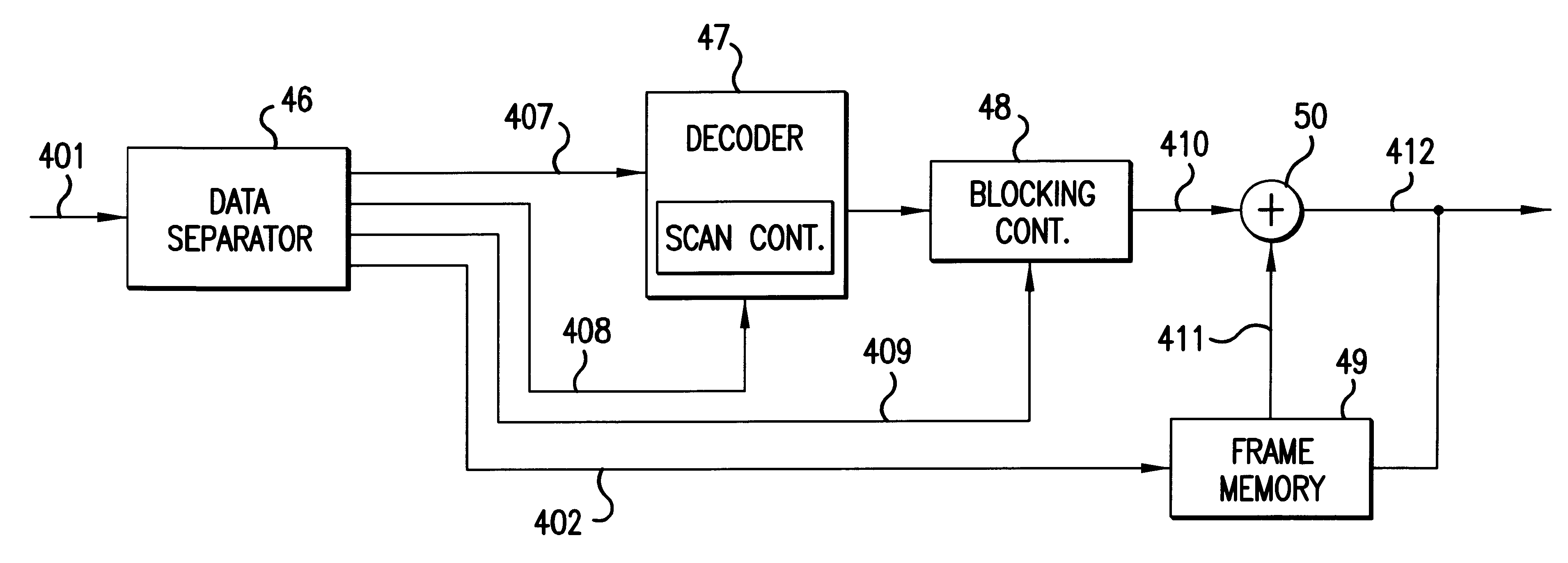Motion compensation predicting encoding method and apparatus
a motion compensation and coding technology, applied in the field of image encoding systems, can solve the problems of low coding efficiency and achieve the effect of efficient quantization
- Summary
- Abstract
- Description
- Claims
- Application Information
AI Technical Summary
Benefits of technology
Problems solved by technology
Method used
Image
Examples
second embodiment
In this second embodiment, an input image signal 300 is input to the motion detector 32 and the memory 41. This input image signal 300 is already organized into blocks. In the motion detector 32, a determination is made in the adaptive composer 39 using the motion vector 302 whether the coding is carried out in a field composition mode or in a field independent mode. For example, when the motion vectors of both the fields are coincident with each other, both the fields are composed.
The adaptive composer 39 composes the field independent prediction error signal 304 into blocks on the basis of the motion vector 302, as shown in FIGS. 7A-7C. In FIGS. 7A-7C, ".largecircle." indicates a pixel of the odd field, and ".quadrature." indicates a pixel of the even field. Further, the shading indicates a difference in illuminance. FIG. 7A shows a block of the prediction error signal 304 in which field composition has been properly carried out, that is, by alternately arranging the pixels of the...
third embodiment
The third embodiment operates as follows. An input image signal 300, which is organized into blocks of even field pixels and blocks of odd field pixels, is fed to the first motion detector 43 and the memory 41. The input image signal 300 is stored in the memory 41. The input image signal 300 is also sent to the first motion detector 43. The previously received image signal 301 is read out of the memory 41 and sent to the first and second motion detectors 32 and 43. The image signal 301 is also sent to the subtracter 34. The first motion detector 43 calculates a motion vector 306 between the odd and even fields of the input image signal 300 and the image signal 301 in the same manner as described above for the previous embodiments. The motion vector 306 is then sent to the MUX 38, the adaptive composer 39, and the adaptive decomposer 40. The second motion detector 32 calculates a motion vector 302 indicating the motion between the odd field of image signal 301 and an odd field of a n...
fourth embodiment
The fourth embodiment operates as follows. In this embodiment, motion compensation is carried out from a frame input signal in which two fields are being composed (i.e., the frame input signal is compared with the frame image data stored in frame memory 33). Specifically, an input image signal 300 that has been obtained by an interlaced scanning is composed into one frame in the field composer 31. The field composing performed by field composer 31 is realized in the manner shown in FIGS. 4A-4C. That is, when the input image signals of the odd and even fields are as shown in FIGS. 4A and 4B, respectively, the lines of these two fields are alternately combined to obtain a field composition frame input signal 301 as shown in FIG. 4C. The obtained field composition frame input signal 301 is sent to the motion detector 32 and the subtracter 34.degree.
In the above discussion, the coder is described as performing the coding by DCT, which is kind of orthogonal transformation. It is, however...
PUM
 Login to View More
Login to View More Abstract
Description
Claims
Application Information
 Login to View More
Login to View More - R&D
- Intellectual Property
- Life Sciences
- Materials
- Tech Scout
- Unparalleled Data Quality
- Higher Quality Content
- 60% Fewer Hallucinations
Browse by: Latest US Patents, China's latest patents, Technical Efficacy Thesaurus, Application Domain, Technology Topic, Popular Technical Reports.
© 2025 PatSnap. All rights reserved.Legal|Privacy policy|Modern Slavery Act Transparency Statement|Sitemap|About US| Contact US: help@patsnap.com



